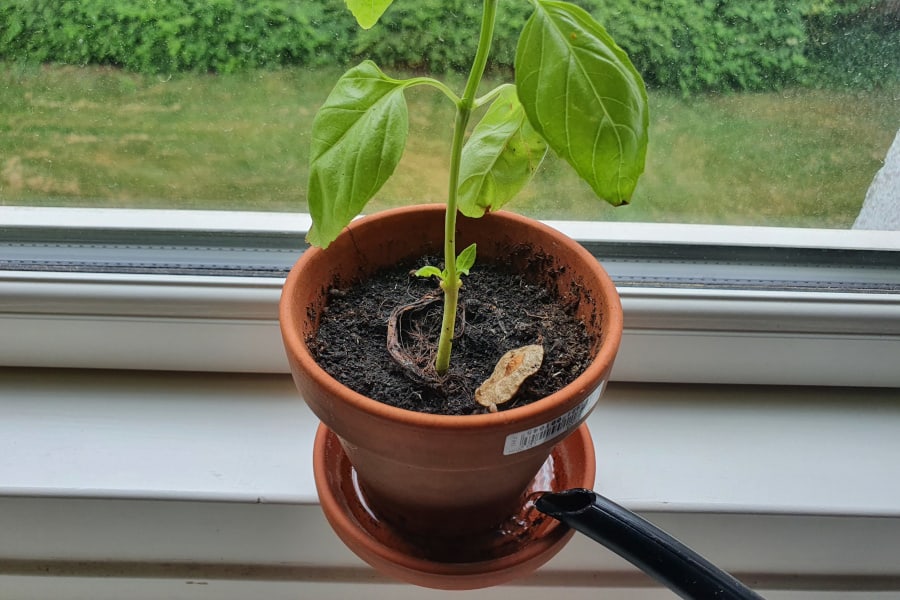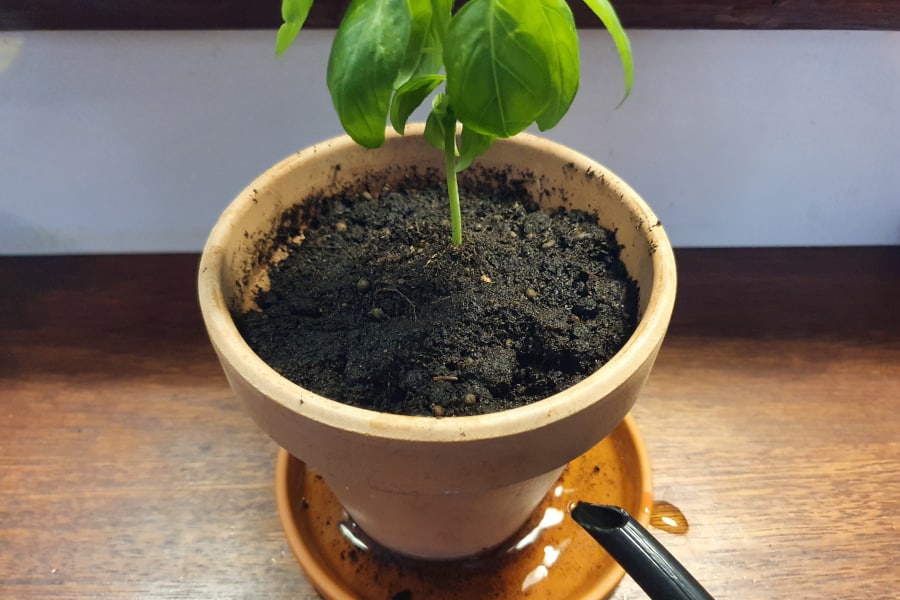This post contains affiliate links.
One of the most common mistakes people make when growing basil is watering the plant wrong. People have debated whether watering from the bottom or the top is best, but in reality, the answer is straightforward. I have written this post to give you the facts and teach you exactly how to do it.
It is best to water basil from the bottom. Doing so encourages the roots to grow so they can better reach the water. As the roots grow, the plant will become more efficient at obtaining water and nutrients from the soil, ultimately resulting in a larger and healthier plant.
In this post, you will learn exactly how and how often you should water your basil plant and why it is better to water many plants, including basil, from the bottom.

Why Watering Basil from the Bottom is Better
While watering basil plants from the bottom is generally better than watering them from the top, it does not mean that watering them from the top is bad. If your basil plant is growing outside, directly in the ground, just water it normally and it will be fine.
If your basil plant is growing in a pot, however, watering it from the bottom is easy and provides several benefits that I will cover here. For this to work, the pot needs one or more holes for drainage and must be placed on a plate or similar such as in the photos above and below. I always use (and recommend) terra cotta pots such as these (link to Amazon).
I explain specifically why I like that type of pot here.
Watering plants from the bottom rather than from the top promotes root growth since the roots are encouraged to grow and stretch to reach the water. This results in larger roots that can absorb more water and nutrients. Conversely, when watering from the top, the roots will not grow as much.
Watering from the bottom rather than from the top is actually also an excellent way to reduce the risk of overwatering.
A good trick to avoid overwatering basil when watering from the bottom is to fill up the plate about halfway, and once the soil has absorbed the water, lightly touch the top of the soil to see if it is dry. If it is still dry, repeat this step until the soil is moist. Basil does not grow well in very dry or very wet soil but rather prefers consistently moist soil.
You can read my complete guide to watering basil on this link, where I explain everything you should know.
Best Way to Water Potted Basil Plants

Basil grows best in soil that is moist but not wet and thrives best when the soil’s moisture level is consistent. The best way to optimize this is to water the plant lightly but often. Less frequent but more heavy watering can damage the plant or inhibit its growth.
Water potted basil from the bottom by pouring water directly into the plate without removing the pot. Watering in the morning allows the plant to obtain the water as efficiently as possible. Basil should generally be watered every 2-3 days or whenever the top of the soil feels dry.
It is best to water basil in the morning as this allows the plant to obtain the water more efficiently throughout the day. The reason for this is that the sun is not as intense in the morning as in the afternoon, so watering in the morning allows the water to sink into the ground, whereas watering in the afternoon can result in the water evaporating before it goes into the ground and your plant has a chance to obtain it.
If your basil plant is at the seeding stage, it is less strong than more mature basil plants and is easier to overwater. Instead of watering basil seedlings as described above, mist them and the soil around them lightly every other day.
Overwatering basil is unfortunately easy and not at all uncommon. I have also done it myself, and when I did, I decided to do some research to find out how to tell if a basil plant is showing signs of overwatering, so I could avoid that mistake in the future. Therefore, I have written another post which you can find on this link, that describes how you can know if your basil plant has been overwatered.
How to Know How Often You Should Water Your Basil Plants
How often you should water your basil plant depends on some things, including the amount of direct sunlight it gets, what temperature it grows in, and how large your plant is.
- Direct sunlight. The more direct sunlight your basil plant is receiving, the faster the water will evaporate.
- Temperature. The higher temperatures your basil plant is growing in, the faster the water will evaporate.
- Size of the plant. As your basil plant grows larger, the amount of water it requires will increase.
Basil plants that receive large amounts of direct sunlight and grow in warm temperatures require more frequent watering than basil plants that grow in less sun and at lower temperatures.
In my experience, watering mature basil plants every 2-3 days, depending on how much sunlight the plant gets, seems to work well. The best way to know if your basil plant needs to be watered is to touch the top of the soil lightly and if it feels dry, water it from the bottom until it is moist.
On the warmest, most sunny summer days, your basil may need to be watered more often than on colder, cloudy days. If your plant is not getting enough water, the leaves will begin to wilt, or droop, which is a way for the plant to reduce the amount of sunlight that reaches its surface.
Read My Complete Guide to Growing and Caring for Basil
I have written a thorough guide where I cover all parts of growing your own basil including choosing a variety, sowing the seeds, the best growing conditions, pruning, propagation, harvesting, storing, solving various problems, and a lot more. You can find the article on this link.
